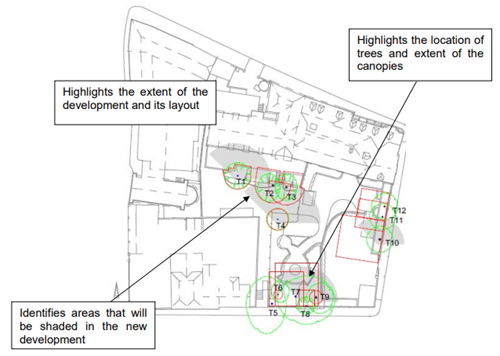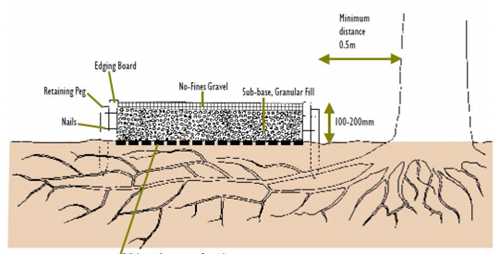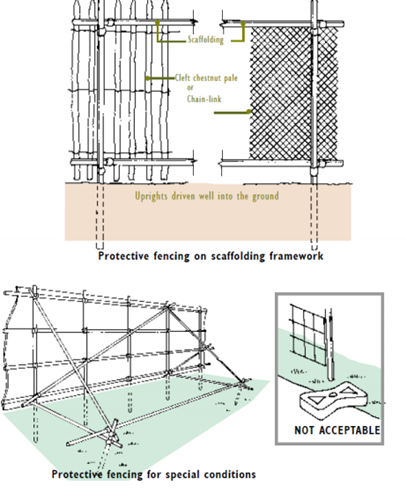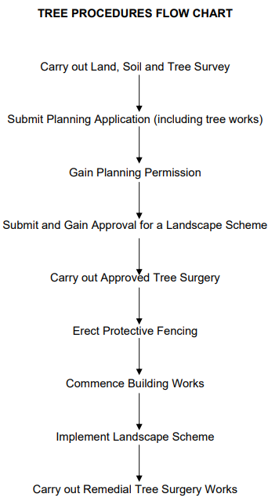Contents
- Introduction
- Trees and the law
- Requirements for planning applications
- Assessing planning applications
- Landscaping Works
- Protecting trees during construction
- Remedial Tree Surgery
- Contact Details
Introduction
Trees can occupy a substantial part of a development site whether residential or commercial. Well sited and in scale with their surroundings, trees will greatly enhance any development by providing an appearance of maturity, which is welcomed and often appreciated. If existing trees are poorly sited, however, they may be resented and no amount of legal protection will ensure their retention.
To avoid such problems, it is of the utmost importance that early and adequate identification of important trees on development sites is carried out.
This guidance aims to provide guidance on which trees are suitable for retention, the means of protecting them, how the development should be integrated and how the existing trees can be supplemented by new planting. This involves a logical sequence of events which are summarised in the flow diagram.
Trees and the Law
When designing a development, whether trees are present or where new planting is envisaged, serious thought must be given to the various legal aspects, which may reduce the site area and cause the site to become undevelopable.
Tree Preservation Orders
Wherever possible the Council will make Preservation Orders on trees which are visible for public open space, contribute in a significant way to the amenity of the area, are healthy and are believed to be in danger of removal or affected by proposed development (see A Methodology for Tree Protection in Bassetlaw). There will be a presumption against any form of development that will adversely affect or require the removal of trees subject to a Preservation Order. Therefore, planning agents and developers will be expected to take great care when dealing with sites containing trees subject to Preservation Orders.
Conservation Areas
All trees above 75 mm in diameter are protected within a Conservation Area. There are some exceptions and it is advised that the District’s Planning Policy Team is contacted (see Section 8) if there is any doubt. A formal notice in writing must be given to the Council six-weeks before any works are to be carried out. This time period allows the Council to make a Tree Preservation Order if it does not agree with the works.
Planning Conditions
When granting planning permission, the District Council can impose certain conditions requiring the protection of trees and in some cases the submission of a landscaping scheme. As with Tree Preservation Orders, conditions will pass from developer to resident or owner from a stated period of time. Failure to adhere to the conditions may result in the Council taking enforcement action against the owner.
Requirements for Planning Applications
Where there are proposals to develop land on which trees of amenity value may be affected, it is usually necessary to request developers to provide specific, detailed information. This is to help us to make a well-informed decision about the proposed development and its likely impact on the trees.
Tree survey information
Guidance is given in British Standard 5837: 2005 Trees in relation to construction. The following is a summary of the information required to comply with the standard. It is important that a tree survey is carried out by a suitably qualified and experienced arboriculturist. The survey information can be used to identify trees for removal and trees for retention and to guide the layout of the development. The tree survey information should include:
- Location of all trees over 75 mm stem diameter measured at 1.5 m above ground level, plus any smaller specimens of particular interest or potential value;
- Location of other arboricultural features such as shrub masses and hedges;
- Location of features such as existing buildings, services, streams;
- Spot heights of ground levels throughout the site as a basis for avoiding changes in soil levels around retained trees;
- Location of trees on adjacent land that might affect, or be affected by, the proposed development;
- Reference number and species of each tree;
- Height in metres;
- Stem diameter in mm, measured at 1.5 m above ground level;
- Branch spread in metres at four compass points;
- Age class;
- Physiological condition;
- Structural condition;
- Preliminary management recommendations;
- Estimated remaining contribution in years;
- Category: R (= remove) A, B or C. Categorisation should be carried in accordance with Table 1 of the British Standard.
An example of a good tree survey, which demonstrates a clear examination of each tree on the site. It considers the position, species, height, stem, crown, age, health and condition.
Tree Survey
| Tree Number | Species | Height | Stem Diameter (mm) | Crown Radius | Crown Height (m) | Age Class | Remaining Contribution | Structural and Physiological Condition | Preliminary Management Recommendation | Retention Category | ||||||
|---|---|---|---|---|---|---|---|---|---|---|---|---|---|---|---|---|
|
N |
E |
S |
W |
|||||||||||||
|
T1 |
Yew (Taxus baccata) |
7 |
255 |
3 |
3 |
3 |
3 |
- |
Mid |
40+ |
Normal |
None |
B1 |
|||
|
T2 |
Lawsons Cypress (Chamaecyparis lawsoniana) |
8 |
400 at base |
2 |
2 |
3 |
3 |
3 |
Mat |
40+ |
Multi Stemmed. Clear stems for 2.5 m |
None |
C1 |
|||
|
T3 |
Lawsons Cypress |
8 |
400 at base |
2 |
3 |
2 |
3 |
3 |
Mat |
40+ |
Multiple stems constrained by various lengths of rope |
None |
C1 |
|||
|
T4 |
Silver Birch (Betula pendula) |
10 |
200 |
3 |
3 |
3 |
3 |
2 |
Mid |
40+ |
Good straight stem. Normal condition. Bird box east side at 3 m |
None |
B1 |
|||
|
T5 |
Wild Cherry (Prunus avium) |
7 |
385 |
7 |
3 |
7 |
6 |
2 |
Y |
40+ |
Average form Average condition |
None |
C1, B2 |
|||
|
T6 |
Common Walnut (Juglans regia) |
5 |
80 |
2 |
2 |
3 |
2 |
2 |
Y |
40+ |
Normal |
None |
C1 |
|||
|
T7 |
Wild Cherry |
8 |
455 |
5 |
7 |
7 |
6 |
2 |
Mat |
20-40 |
Ivy covered stem. Branch decay evident in several branches. Some Canker. Average form. Streetlamp within crown |
Remove decaying branches. Remove ivy and re-inspect |
C1, B2 |
|||
|
T8 |
Holly (Ilex aquifolium) |
6 |
Multi @75 mm |
2 |
2 |
2 |
2 |
2 |
Y |
40+ |
Normal |
None |
C1, C2 |
|||
Tree location and constraints plan
The tree survey information listed above is required to assess which trees, if any, should be retained or removed. The presence of retained trees will act as a constraint on the form and layout of the development and protection areas will need to be installed around retained trees. It is important that the development proposed is capable of being implemented while keeping the protection areas intact. This includes carrying out all the necessary building and engineering works, any demolition works, and providing services and supplies.
An example of a good tree location and constraints plan

Submitted plans should show the following details:
- The location of all service runs, including foul and surface water drainage points, land drains, soakaways, gas, oil, water, electricity, telephone and other infrastructure services;
- Any changes in ground level, including the location of retaining walls, steps and back filling;
- Location of all site huts, temporary latrines (including their drainage), cranes, plant and other temporary structures;
- Location of site construction access;
- Location of storage areas for materials, spoil and fuel, cement and concrete mixing and any contractors’ car parking; and
- Location of visibility splays required at temporary and permanent accesses.
The information provided will help us to ensure the retention of valuable trees for the benefit of all. It will also be used to avoid situations where trees intended to be retained are lost as a result of damage during construction or because of other conflicts with built development.
Assessing planning applications
Once a planning application has been submitted, addressing the criteria discussed in Section 2, the planning department must decide which trees are to be retained and which can be felled. If too many healthy trees need to be felled then either negotiation will need to take place to reduce the housing density or the application will be refused. Conversely, it may be felt that the retention of too many trees may cause future problems with amenity. A balance must be achieved in terms of the relationship between trees and development.
Often, emphasis is placed on retaining the more visually impressive mature and over mature trees while removing the younger and apparently insignificant trees. This is too short sighted; mature trees are less resilient and more likely to die long before new buildings become obsolete. Equal emphasis must be placed, therefore, on the retention of smaller trees, which will generally survive the development surrounding them.
When selecting trees for retention, the overall tree cover should be considered, with long term conservation in mind. There should be a variation in age class throughout the area, which is best achieved by managing the trees as a group rather than as individuals. As over mature trees die, they can be removed and replaced without overall detriment to the appearance of the area. Indeed, placing all the emphasis on a single specimen tree should be avoided. If the tree was to die due to development stress then the rationale for the layout would be destroyed.
Existing trees should be supplemented by new planting, which will provide a diversity of age class as well as filling the spaces where no trees exist. Sufficient space should be left for future growth and development of this planting. It is advisable that where trees are to be planted, consideration should be given to the design of the foundations. In some cases the depth of foundations should be the same as if a mature tree existed in close proximity.
Landscaping Works
Soft landscaping
As part of many planning permissions, conditions are attached requiring the submission of a landscaping scheme. When designing a scheme for residential development the following considerations must be borne in mind to gain the District’s Planning Authority’s agreement:
- The ultimate height and spread of the trees so as not to dominate the garden areas;
- A distance of at least 5 metres must be maintained between the tree’s stem and any dwelling. This should minimise any future damage the tree may cause to the foundations of the properties;
- The choice of species is not only important in terms of size and spread, but the size and density of foliage should be taken into account. Small leaves and a low crown density should be chosen if the tree is on the limit of the 5-metre distance;
- Planting on garden boundaries should be avoided whenever possible, to prevent over-hanging branches and shading of neighbouring gardens. Common law allows neighbours to trim branches back to the boundary line without the owner’s consent, which often leads to disfigured unsightly trees. This is not the case, however, if the tree is subject to a Tree Preservation Order or within a Conservation Area.
When planting is to take place adjacent to the highway, further more detailed considerations are required:
- Sightlines and street-lighting should not be obscured, although complementary design of planting and lighting can enhance the streetscene;
- Failure to allow for high sided vehicles often leads to vehicular damage and lead to drastic pruning, which in turn can disfigure the tree;
- Care should be taken not only when planting but in the design stage, to ensure that services are not damaged or affected. It is advised that early consultation takes place with any statutory undertakers concerned.
Hard Landscaping
The ability of a tree to survive any form of development depends on the tree’s individual circumstances, notably age and vigour. If reasonable protection is adhered to during initial site works and construction, then it is more than likely that the tree will survive. Good work can, however, be undone by the wrong choice of surfacing. The types of material which would be acceptable are as follows:
- Washed gravel is particularly useful where changes in level occur. It is not acceptable, however, where there will be heavy vehicular or pedestrian traffic;
- Paving and slabs should be laid dry-jointed on a sharp sand foundation, which will allow both air and moisture to reach the root system through the interstices;
- Bricks or blocks should be laid dry-jointed directly upon sand or other open foundation materials, which will allow enough moisture and air to permeate to a tree’s root system;
- The majority of a tree’s root system occurs in the upper 600 mm of soil so great care and thought should be given to the type of edging used to hold the above materials in place. The excavations needed to accommodate standard kerb construction would lead to root severance.
- Instead of excavations, it may be more appropriate for the surfacing to be laid on the existing soil surface. The existing surface must not be screeded, however, but the vegetation killed off using a suitable weedkiller. The levels should not be built up more than 100 mm. The materials noted above can be used as long as a granular foundation is used to allow gaseous diffusion.

Protecting Trees During Construction
Generally speaking, trees that are growing vigorously will have achieved equilibrium with their surroundings. Any alteration to this equilibrium will have serious implications for the tree.
The most misunderstood feature of a tree is its root system, because it is underground. The root system is, however, the most vulnerable part of a tree and any damage may at best reduce a tree’s vigour but at worst may render the tree unstable. Points to consider include:
- The majority of the root system is within the top 600 mm of soil, extending far beyond the span of the crown of the tree. The extent of the root system is very irregular. It will not mirror the branch system and its spread is very much dependent on the soil conditions.
- The root system has three main uses: anchorage; food storage; and absorption of oxygen and nutrients. Roots absorb both water and nutrients from the soil, which during the dormant period are stored within the root system. Any damage, therefore, will prevent the absorption of nutrients and sever the food store. Vigorous young trees will be capable of rapid root regeneration with a reduced loss of vigour, but mature trees will, in most cases, die.
- If a tree’s ability to diffuse carbon dioxide is inhibited then the tree will slowly suffocate, ultimately killing the root system. Diffusion will be inhibited by impervious surfacing or the compaction of clay soils (which particularly affect eastern Bassetlaw).
- To prevent root damage occurring, the tree should be protected by fencing ). The area within the fencing should be seen as sacrosanct, with all materials and constructional activities excluded from it. If it is unavoidable for excavations to be carried out within these distances, then the Council’s Planning Policy Team must be contacted.
- Although the protective fencing will protect the root system from compaction and physical damage, further indirect damage may be caused by the following:
- The spillage of toxic materials such as petrol or diesel;
- The mixing of cement due to the amount of lime within the mixture;
- The lighting of fires within close proximity of the branch structure.
To avoid damage by the above it is important that the following measures be carried out:
- No materials should be stored within 10 metres of any tree;
- Concrete mixing should not be carried out within 10 meters of any tree and allowances for ground slopes should be made to prevent caustic materials running towards a tree;
- No fires should be lit in a position where the flames could extend to within 5 metres of the foliage. With large fires, this may necessitate keeping the fire at least 20 metres from the tree.
- It must be considered that trees can cause structural damage to dwellings, if sufficient distances are not maintained or foundations are not to sufficient depth. Dwellings should not be sited in such a way that the retained trees will cause structural damage.
- Great care must be taken at all times when using machinery, especially rear mounted excavators, so that the branches are not damaged.

| Tree Condition | Trunk Diameter (mm) | Minimum Distance (m) |
|---|---|---|
| Young Trees (Normal Vigour) | >200 200-400 >400 |
2.0 3.0 4.0 |
| Young Trees (Low Vigour) | >200 200-400 >400 |
3.0 4.5 6.0 |
| Middle Aged Trees (Normal Vigour) | >250 250-500 >500 |
3.0 4.5 6.0 |
| Middle Aged Trees (Low Vigour) | >250 250-500 >500 |
5.0 7.5 10.0 |
| Mature Trees (Normal Vigour) | >350 350-700 >750 |
4.0 6.0 8.0 |
| Mature Trees of Low Vigour and Over Mature Trees | >350 350-750 >750 |
6.0 9.0 12.0 |
Remedial Tree Surgery
Even when trees have been retained on development sites, with the recommended protection carried out, a certain amount of die-back can be expected. Trees may be already stressed before construction commences and the development may accelerate the deterioration of the tree.
Before contemplating any work to trees, first check with the Council that any work can be carried out without consent and, secondly, inspect the tree overall to ascertain the symptoms and the causes of any damage. The more obvious signs of damage, such as broken branches, should be removed immediately but unless there are major amounts of dead wood within the crown the tree should be left alone.
Major amounts of tree surgery should be avoided until the tree has achieved equilibrium with its new surroundings, which may take upwards of five years. Depending on individual circumstances, trees could be already stressed and any removal of large areas of leaf could result in the ultimate death of the tree.
On development sites, water uptake is drastically reduced due to soil compaction and root death. Provided that the soil conditions are acceptable to root growth the imbalance will only be temporary. Depending on the size of the tree involved, careful irrigation may help matters. Too much water, however, can starve the root system of oxygen thus worsening the situation. Soil compaction can be alleviated to some extent by the use of a hand held auger or, although expensive, large areas may be repaired by the introduction of air under pressure.
Fertilisers should not be applied to the soil unless proper advice from an arboriculturist is sought. An excess of some inorganic fertilisers in the soil can be damaging to the tree. Only when foliar analysis has taken place should general fertiliser applications be made.
Contact Details
If you require any further information, please contact the Planning Team on 01909 533 533 or email: planning@bassetlaw.gov.uk
ALL TREE WORKS WILL BE MONITORED BY THE COUNCIL PLANNING DEPARTMENT
Last Updated on Monday, June 17, 2024
